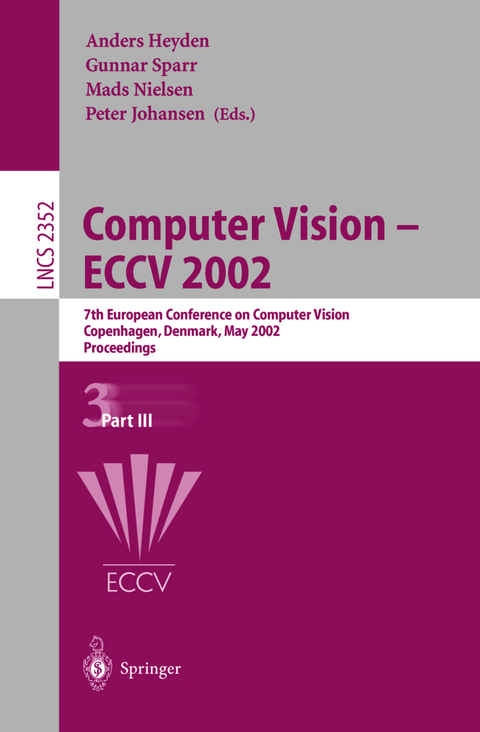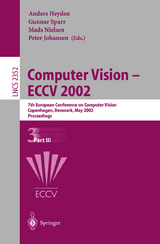Computer Vision - ECCV 2002
Springer Berlin (Verlag)
978-3-540-43746-8 (ISBN)
Shape.- 3D Statistical Shape Models Using Direct Optimisation of Description Length.- Approximate Thin Plate Spline Mappings.- DEFORMOTION Deforming Motion, Shape Average and the Joint Registration and Segmentation of Images.- Region Matching with Missing Parts.- Stereoscopic Vision I.- What Energy Functions Can Be Minimized via Graph Cuts?.- Multi-camera Scene Reconstruction via Graph Cuts.- A Markov Chain Monte Carlo Approach to Stereovision.- A Probabilistic Theory of Occupancy and Emptiness.- Texture Shading and Colour / Grouping and Segmentation / Object Recognition.- Texture Similarity Measure Using Kullback-Leibler Divergence between Gamma Distributions.- All the Images of an Outdoor Scene.- Recovery of Reflectances and Varying Illuminants from Multiple Views.- Composite Texture Descriptions.- Constructing Illumination Image Basis from Object Motion.- Diffuse-Specular Separation and Depth Recovery from Image Sequences.- Shape from Texture without Boundaries.- Statistical Modeling of Texture Sketch.- Classifying Images of Materials: Achieving Viewpoint and Illumination Independence.- Estimation of Multiple Illuminants from a Single Image of Arbitrary Known Geometry.- The Effect of Illuminant Rotation on Texture Filters: Lissajous's Ellipses.- On Affine Invariant Clustering and Automatic Cast Listing in Movies.- Factorial Markov Random Fields.- Evaluation and Selection of Models for Motion Segmentation.- Surface Extraction from Volumetric Images Using Deformable Meshes: A Comparative Study.- DREAM2S: Deformable Regions Driven by an Eulerian Accurate Minimization Method for Image and Video Segmentation.- Neuro-Fuzzy Shadow Filter.- Parsing Images into Region and Curve Processes.- Yet Another Survey on Image Segmentation: Region and Boundary Information Integration.- Perceptual Grouping from Motion Cues Using Tensor Voting in 4-D.- Deformable Model with Non-euclidean Metrics.- Finding Deformable Shapes Using Loopy Belief Propagation.- Probabilistic and Voting Approaches to Cue Integration for Figure-Ground Segmentation.- Bayesian Estimation of Layers from Multiple Images.- A Stochastic Algorithm for 3D Scene Segmentation and Reconstruction.- Normalized Gradient Vector Diffusion and Image Segmentation.- Spectral Partitioning with Indefinite Kernels Using the Nyström Extension.- A Framework for High-Level Feedback to Adaptive, Per-Pixel, Mixture-of-Gaussian Background Models.- Multivariate Saddle Point Detection for Statistical Clustering.- Parametric Distributional Clustering for Image Segmentation.- Probabalistic Models and Informative Subspaces for Audiovisual Correspondence.- Volterra Filtering of Noisy Images of Curves.- Image Segmentation by Flexible Models Based on Robust Regularized Networks.- Principal Component Analysis over Continuous Subspaces and Intersection of Half-Spaces.- On Pencils of Tangent Planes and the Recognition of Smooth 3D Shapes from Silhouettes.- Estimating Human Body Configurations Using Shape Context Matching.- Probabilistic Human Recognition from Video.- SoftPOSIT: Simultaneous Pose and Correspondence Determination.- A Pseudo-Metric for Weighted Point Sets.- Shock-Based Indexing into Large Shape Databases.- EigenSegments: A Spatio-Temporal Decomposition of an Ensemble of Images.- On the Representation and Matching of Qualitative Shape at Multiple Scales.- Combining Simple Discriminators for Object Discrimination.- Probabilistic Search for Object Segmentation and Recognition.- Real-Time Interactive Path Extraction with On-the-Fly Adaptation of the External Forces.- Matching and Embedding through Edit-Union of Trees.- A Comparison of Search Strategies for Geometric Branch and Bound Algorithms.- Face Recognition from Long-Term Observations.- Stereoscopic Vision II.- Helmholtz Stereopsis: Exploiting Reciprocity for Surface Reconstruction.- Minimal Surfaces for Stereo.- Finding the Largest Unambiguous Component of Stereo Matching.
| Erscheint lt. Verlag | 17.5.2002 |
|---|---|
| Reihe/Serie | Lecture Notes in Computer Science |
| Zusatzinfo | XXVIII, 919 p. |
| Verlagsort | Berlin |
| Sprache | englisch |
| Maße | 155 x 235 mm |
| Gewicht | 1160 g |
| Themenwelt | Informatik ► Grafik / Design ► Digitale Bildverarbeitung |
| Mathematik / Informatik ► Informatik ► Software Entwicklung | |
| Informatik ► Theorie / Studium ► Künstliche Intelligenz / Robotik | |
| Schlagworte | 3D • 3D Reconstruction • algortihmic learning • camera calibration • Classifiers • Clustering • Cognition • Computational Geometry • computer vision • face recognition • fuzzy • Geometric Computation • Hardcover, Softcover / Informatik, EDV/Informatik • HC/Informatik, EDV/Informatik • Image Processing • Image Segmentation • learning • motion tracking • Multiple Images • Object recognition • Robot vision • Shading • shape reconstru • shape reconstruction • Stereo Vision • Vision Algorithms • vision systems |
| ISBN-10 | 3-540-43746-0 / 3540437460 |
| ISBN-13 | 978-3-540-43746-8 / 9783540437468 |
| Zustand | Neuware |
| Haben Sie eine Frage zum Produkt? |
aus dem Bereich




